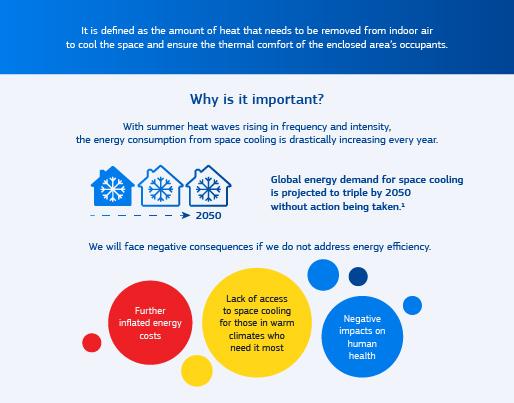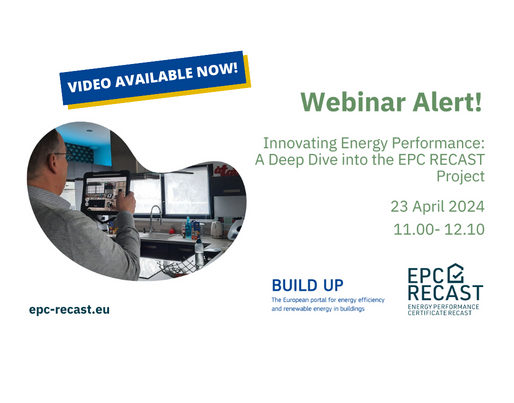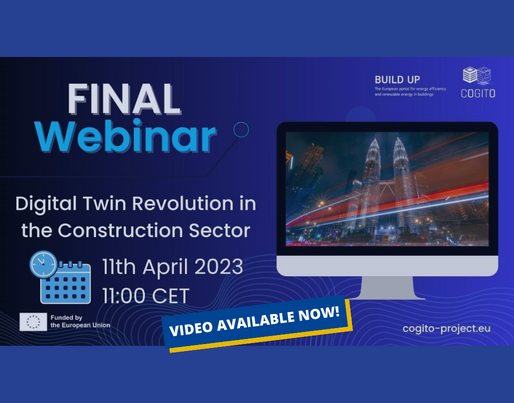Infographic - How we cool indoor spaces and sustainable alternatives we have

Infographic - How we cool indoor spaces and sustainable alternatives we have
Infographic - How we cool indoor spaces and sustainable alternatives we have
What is space cooling?
It is defined as the amount of heat that needs to be removed from indoor air to cool the space and ensure the thermal comfort of the enclosed area’s occupants.
Why is it important?
With summer heat waves rising in frequency and intensity, the energy consumption from space cooling is drastically increasing every year.
Global energy demand for space cooling is projected to triple by 2050 without action being taken.
We will face negative consequences if we do not address energy efficiency:
- Further inflated energy costs.
- Lack of access to space cooling for those in warm climates who need it most.
- Negative impacts on human health.
There are two types of space cooling technologies on the market
Passive: Do not require use of mechanical or electrical devices.
Some examples:
- Blinds,
- Building insulation combined with proper ventilation (Drawbacks in case of lack of ventilation: inside overheating, poor IAQ, mold.),
- Green roofs/walls,
- Water bodies,
- Wind catchers
Active: Require external energy, e.g. air conditioning systems.
Solutions already on the market:
- Vapour compression,
- EU market breakdown (almost 99% of the final energy consumption for space cooling in the current European market is covered by vapour compression systems),
- Thermally driven heat pumps (around 1% is covered by thermally driven heat pumps),
Are there alternative solutions?
Many less energy-intensive technologies have been conceived over the years, but they have not been developed to the point of being a viable competition.
- Solar cooling systems.
- Reversible ground source heat pumps.
- District cooling systems.
Moreover, there is lack of R&D for such alternative solutions which hinders the competitiveness of such equipment, and the technology is expensive.
Energy Input: Alternative solutcions
Electrical
- Thermoelectric
- Thermionic
- Thermotunnel
- Electrocaloric
- Electrochemical
Mechanical
- Pulse tube
- Ejector
- Vortex tube
- Stirling/Eric(c)son cycles
- Reverse Brayton
- Bernoulli cycle
- Elastomeric effect
- Critical flow cycle
- Membrane heat pump
Acoustic
- Thermoacoustic
Magnetic
- Magnetocaloric
Chemical
- Dessicant
- Heat of reaction
Hydraulic
- Potential energy use
Thermal
- Transcritical thermal compression heat pump
Natural
- Natural convection
- Natural conduction
- Freeze/melt cycle
- Evaporative cooling
- Enthalpy recovery
(Source: 2 https://data.europa.eu/doi/10.2833/799633)
There are many challenges and opportunities in the cooling sector!
There are many possible alternatives to conventional solutions, but there is a lack of information regarding
- Potential cost
- Applicability
- Efficiency benefits
What should be done?
- Alternative technologies should be developed and tested to make them more efficient and competitive on the market.
- The input of energy from local renewable sources should increase, and renewable cooling equipment (e.g. solar cooling systems) should be boosted in buildings.
- Incentives and subsidies for cooling should be enhanced at local, national level, and EU level
In 2021 and for the first time in history, the European Commission established a methodology for calculating the quantity of renewable cooling and district cooling that can be counted towards EU renewable energy targets.3 The methodology set a threshold below which or above which cooling systems respectively cannot be or can be considered renewable.
This rewards technologies such as reversible heat pumps and free cooling by district cooling networks, while also incentivising the deployment of solar cooling and thereby the use of renewable sources.
Several EU funded projects are working in this context, to develop tools and raise awareness about the alternatives for space cooling technologies.
Coollife: Promotes innovative space cooling technologies and the use of available local renewable energy supply, developing open-source tools for decision-making, planning, design, and implementation processes.
Cooling down: aims to address the contribution of renewable cooling technologies such as geothermal and solar thermal sources.
Life Superhero: promotes innovative building passive cooling concept and aims to diffuse the use of the Ventilated and Permeable Roofs and HEROTILE-based roof in existing and new buildings.
Cooltorise: aims to reduce summer energy poverty incidence among European households, improving their indoor thermal habitability conditions and reducing their energy needs during the hot season.
[August 2023 Credits: Eurac Research / Other sources: 1 The Future of cooling report, IEA, 2018; 2 European Commission, Directorate-General for Energy, Pezzutto, S., Novelli, A., Zambito, A., et al., Cooling technologies overview and market shares. Part 1 of the study “Renewable cooling under the revised Renewable Energy Directive ENER/C1/2018-493”, Publications Office of the European Union, 2022, https://data.europa.eu/doi/10.2833/799633; 3 Directorate-General for Energy, https://commission.europa.eu/news/european-commission-adopts-new-methodology-rules-renewable-cooling-2021-12-16_en BUILD UP is an initiative managed by the European Commission’s European Climate Environment and Infrastructure Executive Agency (CINEA)]
In this infographic you will learn more about sustainable alternatives to cool indoor spaces, you can see different existing types of technologies in the market and sustainable cooling opportunities in the cooling sector.
In addition, you can discover some EU funded projects that are working on sustainable cooling technologies.
What is space cooling?
It is defined as the amount of heat that needs to be removed from indoor air
to cool the space and ensure the thermal comfort of the enclosed area’s occupants.
Why is it important?
With summer heat waves rising in frequency and intensity,
the energy consumption from space cooling is drastically increasing every year.
Find more information about Space Cooling Technologies for buildings here.
Find the complete infographic in the link below.
How_we_cool_indoor_spaces_and_what_sustaiblable_alternatives_we_have-Infographic
English (425.01 KB - PDF)

